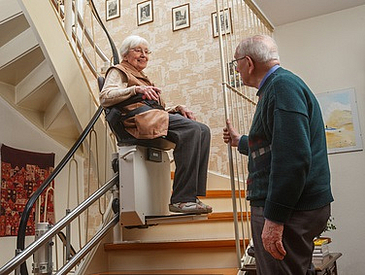The main topic featured in the BARMER GEK Care Report 2015 is the scientific analysis of care at home. A total of 1,850 insured persons responded to the survey. This is the eighth time the care report has appeared. It is compiled by a work group in the Research Center for Inequality and Social Policy (SOCIUM, formerly: Center for Social Policy) at the University of Bremen led by Professor HeinzRothgang. In addition to the main topic, the authors – besides Professor Rothgang they are Thomas Kalwitzki, Dr. Rolf Müller, Rebecca Runte and Dr. Rainer Unger – look into other central developments unfolding in the area of care. An important source of data the report is based on are the care statistics encompassing around 2.6 million people in need of care, the socio-economic panel, and routine statistics compiled by BARMER GEK, encompassing around ten percent of the population.
Half of all persons in need of care live in accommodation that is not suitable for elderly persons – in spite of this, insurance payments for accordant home improvements are rare
More than half of all persons being cared for at home live in accommodation that is not suitable for elderly persons. The authors of the Report therefore expect that demand for subsidies financed by care insurance to enable and facilitate care at home, currently amounting to 4,000 euros for home improvement measures, will be higher in future. This even more so since 97 percent of the insured persons surveyed who claimed subsidies in the past say the grants are very useful. Only around 3.5 of all persons being cared for at home (= 65,000 people) take advantage of the subsidies available to them. The six subsidies most applied for were for, in order of importance: shower, stair lift, handrail, WC, grab handle, ramp.
There are two main reasons why the subsidies are not applied for more often. On the one hand, 72 percent of the users have to pay a higher amount for the home improvement than the subsidy, which clearly has a dissuasive effect. This effect was mitigated by the increase of the subsidy from 2,557 euros to 4,000 euros that came into effect on January 1, 2015. If the new higher ceiling had been introduced for 2014, the proportion of beneficiaries who had to pay more than the amount of the subsidy would only have been 47 percent. On the other hand, the contact points fail to adequately communicate the entitlement to subsidies: Only half the users received the information from their insurers, medical services, or care providers. Almost one third of those persons who had not applied for a subsidy say they were unaware that such subsidies exist. Almost half of the persons surveyed who carried out accordant home improvements for their own account were unaware that subsidies were available for home improvements from the care insurance. There are clearly very wide information gaps.
Pflegestärkungsgesetz II – a very generous reform
A central reform contained in the Pflegestärkungsgesetz II [Care improvement law] passed last week by the German Parliament is the new definition of “in need of care” that many people have called for over past years. The implementation is in several aspects unexpectedly generous: Firstly, the assessment systematics of the new expert assessment vis-à-vis the recommendations of the expert panel have changed in so many respects that now more persons qualify as being in need of care, and at the same time more persons find themselves lifted into a higher care category. Secondly, of the three proposals put forward by the expert panel in respect of transition from recognized persons in need of care from care levels to care degrees, the most generous was selected. Thirdly, the payment levels for the new care degrees are defined so that the payments expressly deemed by the Pflegeneuausrichtungsgesetz [New care orientation law] to be of transitory character are now granted on a permanent basis – and this applies not only to persons with limited everyday competences but for all persons in need of care.
Finally, the reform contains a comprehensive grandfathering clause, as result of which from outpatient up to changeover date 95 percent of those persons receiving care benefits will be better off, and nobody will be worse off. Moreover, in the long-term view there will only be few persons who are likely to be worse off under the new system.
The number of persons in need of care is rising faster than previously thought, care is becoming more “male”, and the proportion of very old people in need of care is rising
On the basis of census carried out in 2011 and the – new – 13th coordinated population projection compiled by the Federal Statistics Bureau, the number of persons in need of care by 2060 (2055) is expected to rise to 4.52 million (4.64 million), and there will therefore be an additional 221,000 (164,000) persons in need of care compared with earlier projections. At the same time, care will be more “male” since by the year 2060 there will be an additional 176,000 men in need of care compared with “only” an additional 45,000 women. As of 2040, there will be a drastic ageing of the population in need of care. Whereas in 2015 around 30 percent of all men in need of care were 85 and older, by the year 2060 the proportion will have reached almost 60 percent. Women will also be getting noticeably older. Whereas in 2015 the proportion of women aged 85 and older is around 50 percent, by the year 2060 this proportion will have risen further to almost 70 percent. Hence, in future there will have to be a gradual shift of focus onto very old people and accordant infrastructures.
For more information on this topic, please contact:
University of Bremen
SOICIUM (Research Center for Inequality and Social Policy)
Dr. Rainer Unger
Phone: +49 421 218 58553
e-mail: Rainer.Ungerprotect me ?!uni-bremenprotect me ?!.de
www.zes.uni-bremen.de

